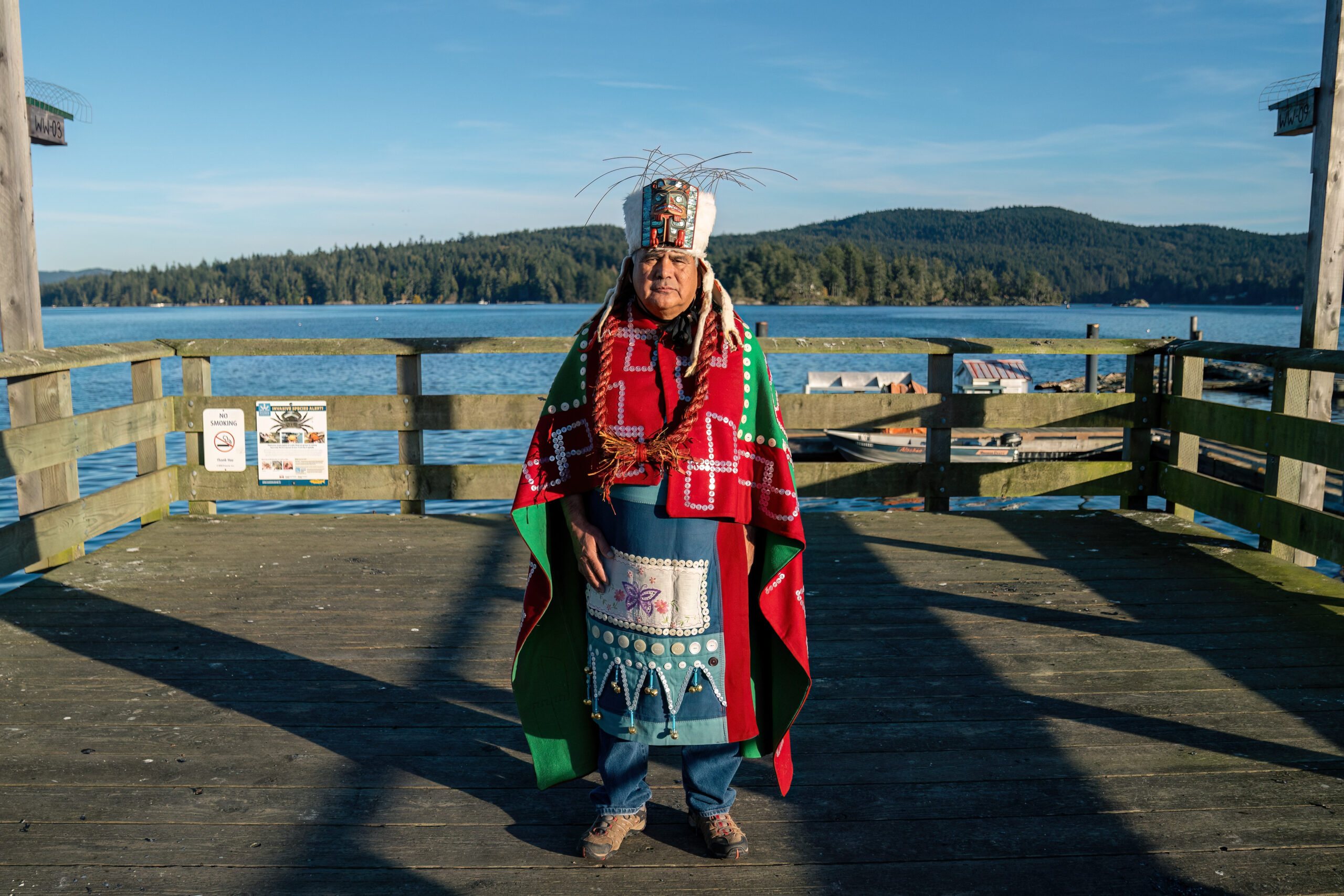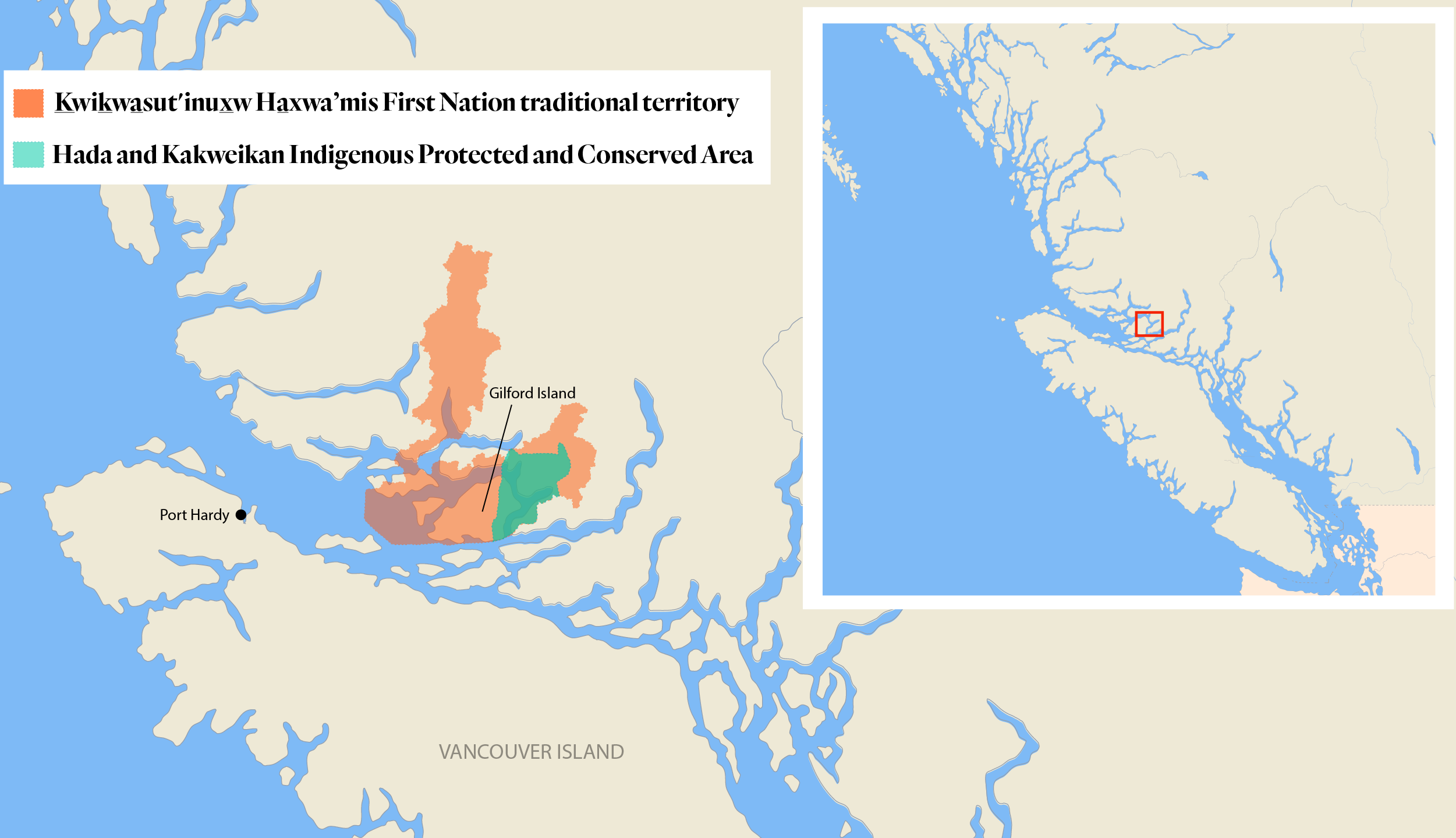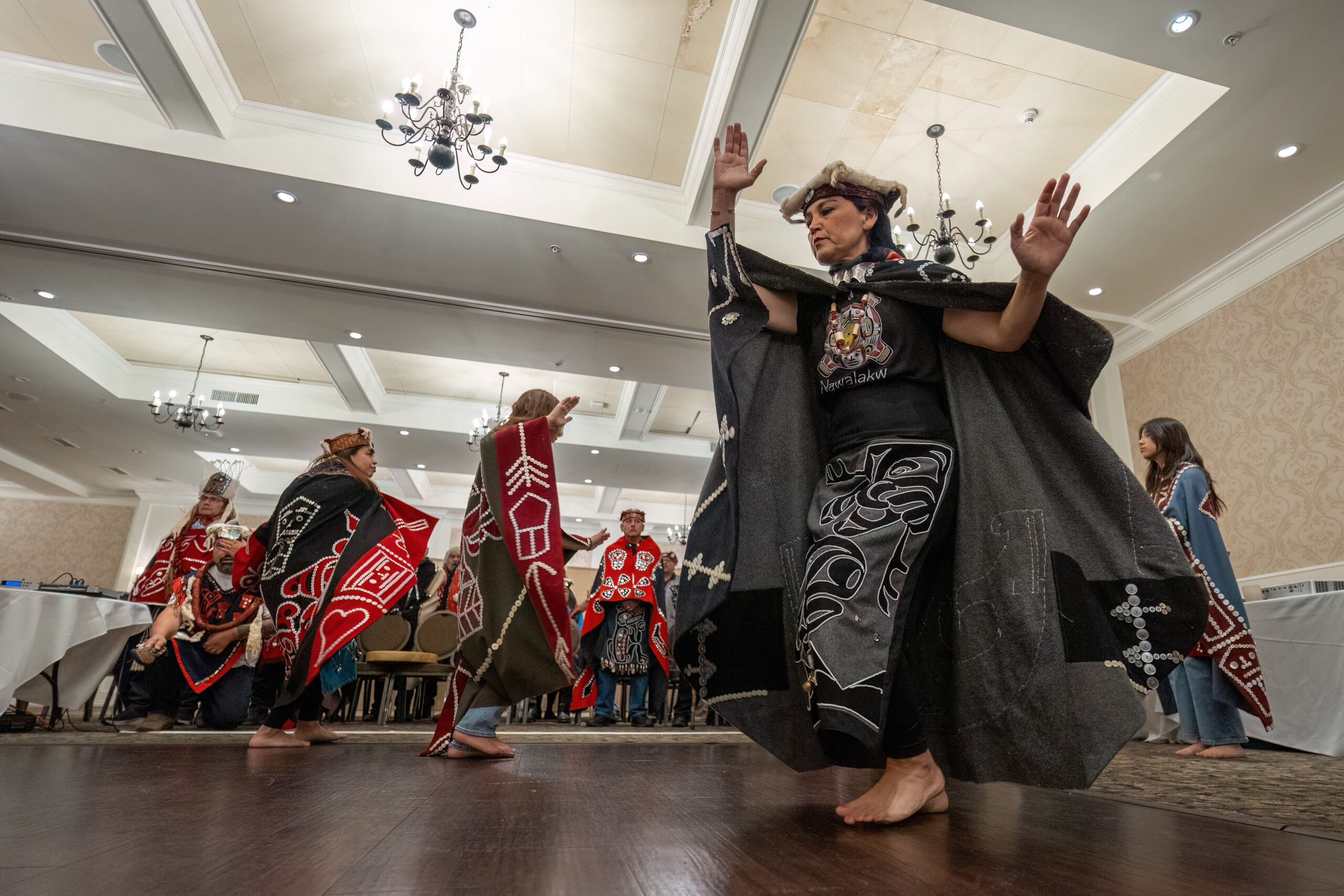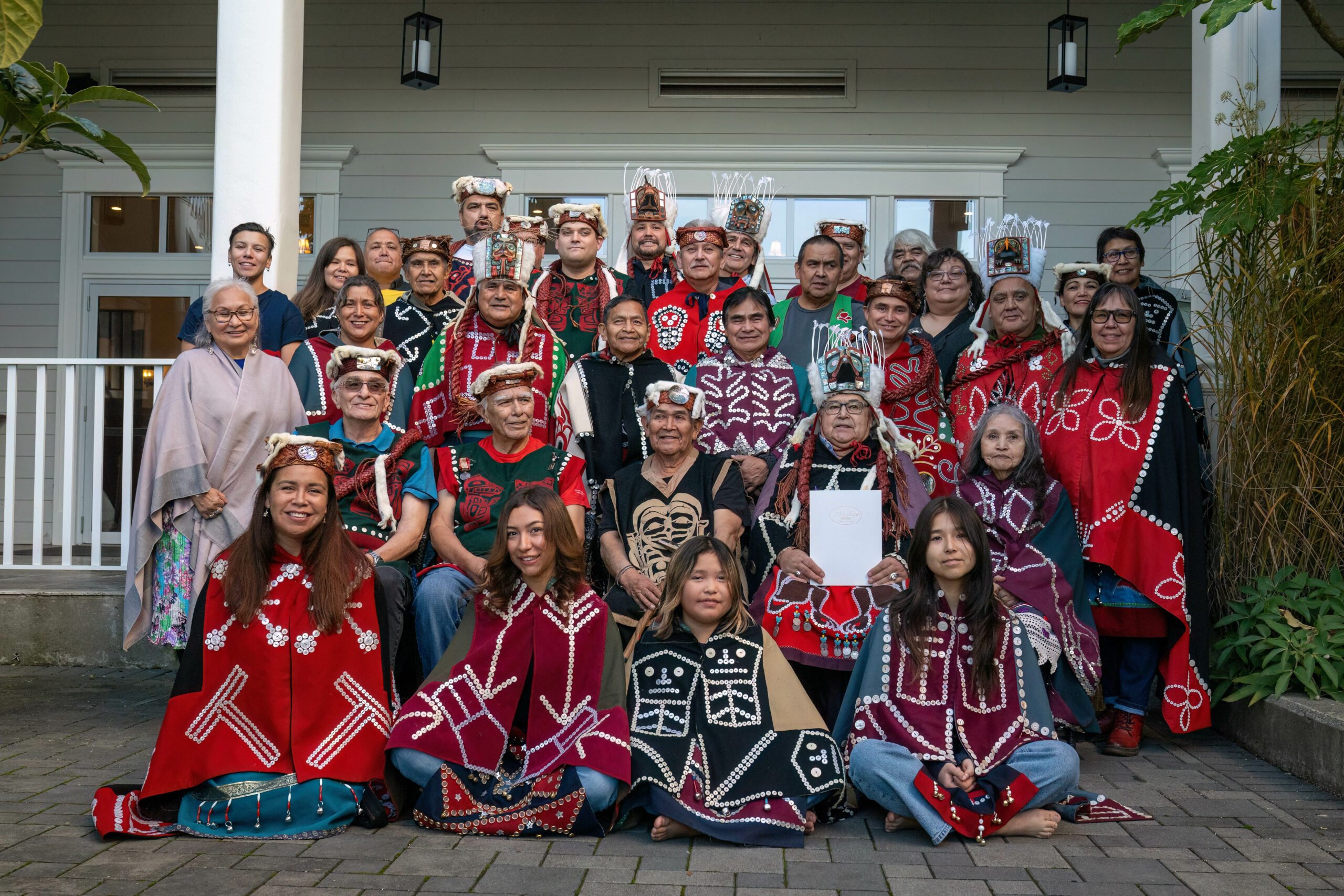
Drawing (on) a decade of climate change in the North
Artist Alison McCreesh’s latest book documents her travels around the Arctic during her 20s. In...
In a conference room at an oceanfront hotel in Sooke, B.C., surrounded by Hereditary Chiefs wearing regalia of white ermine headdresses, red and black button blankets and cedar bark garlands, Rick Johnson picked up a pen to sign a declaration.
The elected and Hereditary Chief of the Ḵwiḵwa̱sut’inux̱w Ha̱xwa’mis First Nation, whose territory lies several hundred kilometres north of Vancouver, on B.C.’s remote mid-coast, had travelled to Sooke for a three-day “estuary to old-growth” gathering of 20 First Nations. As more than 80 people met on Nov. 16 to discuss old-growth logging deferrals and Indigenous stewardship, Johnson and his nation seized the moment to demonstrate their authority over what happens on their territory, declaring Hada and Kakweikan (Bond Sound and Thompson Sound) an Indigenous Protected and Conserved Area (IPCA).
The unilateral declaration invokes the nation’s inherent rights and title, jurisdiction and decision-making authority to protect more than 41,000 hectares of its land and waters, “from mountaintop to seafloor,” that are a breadbasket for its people.
For far too long, the Chief said in an interview, the nation’s territory has been impacted by overfishing — and the declaration notes the depletion of cherished and culturally important species such as eulachon, littleneck clams, Pacific herring and Pacific salmon.

“It’s like we’re invisible,” Johnson told the gathering. “We watch industry pass by on a daily basis [while] we suffer with Third World conditions in our village,” Gwa’yasdams, on Gilford Island in the Broughton Archipelago. Drinking-water quality and housing are below Canadian standards, the Chief pointed out. “And we don’t profit a penny from the resources that are extracted from our lands.”
These are the conditions, Johnson said, that led the nation to declare the protected area “and reclaim what is already ours.” The protected area includes salmon-bearing watersheds, traditional villages and other sites representative of the nation’s rich cultural heritage.
Indigenous Protected and Conserved Areas are gaining recognition worldwide for their role in preserving biodiversity and securing a space where communities can actively practice their ways of life. A number of First Nations in B.C., including the Gitanyow, have declared protected areas without support from the B.C. government, serving notice that Indigenous people remain the true stewards of their lands. While Indigenous Peoples protect and conserve lands and waters in many forms, IPCAs are a form of conservation that has gained great momentum since 2018.
The newly declared IPCA, supported by the Musgamagw Dzawada’enuxw Hereditary Chiefs, is part of a wave of First Nations declaring protected areas under their own jurisdiction and outside the designation of any Crown government. It’s adjacent to the 10,416-hectare protected area that the Mamalilikulla First Nation declared in 2021. The same year, Gitanyow Hereditary Chiefs unilaterally declared the 54,000-hectare Wilp Wii Litsxw Meziadin Indigenous Protected Area in northwest B.C. Last year, Kitasoo Xai’xais issued its own declaration protecting a 3,350-hectare marine protected area. In March, the Simpcw First Nation declared the Raush River watershed an IPCA, signalling their intention to protect the Raush Valley in southern B.C. and exercise their right to control what happens there.
In its IPCA declaration, the Ḵwiḵwa̱sut’inuxw̱ Ha̱xwa’mis First Nation said its stewardship of the area will focus on culture and language, protecting habitat and archaeological resources, food security and generating a sustainable economy.

The nation invited the federal and provincial governments to support its IPCA — but asserted the declaration is protected under pre-existing Ḵwiḵwa̱sut’inux̱w Ha̱xwa’mis law, and affirmed by First Nations’ rights enshrined in the constitution.
In an emailed statement in response to questions, the B.C. Ministry of Water, Land and Resource Stewardship said the government respects and acknowledges the efforts of Ḵwiḵwa̱sut’inux̱w Ha̱xwa’mis First Nation to protect ecosystems within their territories “and care for the water, land, animals and other natural resources that their communities have relied on for millennia.”
The ministry said it is committed to working together with First Nations on a co-managed approach to land and resource management. “Where possible, our preferred approach is for Indigenous-led stewardship interests, such as IPCAs, to be addressed through government-to-government collaborative processes like modernized land use planning,” the ministry said. “This ensures that economic, environmental, social and cultural values are considered, that collaborative processes can be built with First Nations and that robust engagement can be undertaken with stakeholders, local government and the public.”
The ministry said the government welcomes the opportunity to work with Ḵwiḵwa̱sut’inux̱w Ha̱xwa’mis First Nation “to better understand and share our collective perspectives and to jointly develop an approach to land stewardship.”
In a statement to The Narwhal, Environment and Climate Change Canada (ECCC) said it supports the creation of IPCAs but was not directly involved in the creation of the Hada and Kakweikan protected area. The department stated it “does not determine what is, or is not, an Indigenous Protected and Conserved Area (IPCA) and ECCC does not designate IPCAs.” The federal government can participate in the establishment of Indigenous-led protected areas through funding or co-management agreements but the department confirmed the Ḵwiḵwa̱sut’inux̱w Ha̱xwa’mis First Nation did not receive funding for this current initiative.
Numerous provincial and federal crown tenures and land-use designations — including for log-handling, commercial recreation and commercial and sport fishing — are in place throughout the declared IPCA. The nation said it will review existing parks, conservancies, tenures and other designations issued by the Crown for “the use of our lands, waters and ma’mikas (natural resources) within the IPCA without the free, prior and informed consent of the Ḵwiḵwa̱sut’inux̱w Ha̱xwa’mis First Nation.”
In an interview following the declaration ceremony, which included a traditional salmon dance, Chief Johnson spoke about the alarming depletion of salmon stocks in the territory. “It’s going to take a commitment from both the federal and provincial government to rebuild our stocks, a serious commitment,” he said.

The Atla River supports pink, chum, coho and a small run of sockeye salmon, while the Kakweikan River was once a spawning ground for all five species of Pacific salmon.
Working with other First Nations in the Broughton Archipelago, the nation recently succeeded in removing Atlantic salmon pens from waters in its territory. The IPCA declaration is the next step in protecting all salmon migratory routes and ensuring the safety of all wild salmon populations, the nation said in its declaration.
Johnson described Hada as “a very sacred place to us,” where the nation’s first ancestor Hawilkwalal (Cedar Dancer) was born and lived and built his first Big House, and Kakweikan as “another absolutely beautiful place, very important to the Ḵwiḵwa̱sut’inux̱w Ha̱xwa’mis people.”
“The declaration is going to give us the ability to have a say in what we want there, what we want to put there.”
In Hada (Bond Sound), the nation has established a language and cultural revitalization centre, the Chief pointed out. “Our kids are going back, learning the language, building their self-esteem, finding out who they are . . . The crime rate has come down. The alcohol abuse has come down. Kids have a purpose now, they’re understanding who they are. For us to have a say in what goes on in Bond Sound, for instance, is a tremendous step forward as Ḵwiḵwa̱sut’inux̱w Ha̱xwa’mis people.”
The next step is to look at other areas urgently in need of conservation, the Chief said. “There are watersheds that are in deep trouble in our traditional territory, in deep, deep trouble for a lot of reasons — from climate change, overfishing, et cetera.” The nation may also eventually declare adjoining Viner Sound an Indigenous protected area, he said. The river in the sound used to be filled with chum salmon, “and now we’re down to a handful.”
Johnson said the nation also needs an Indigenous Guardians program. Indigenous Guardians are trained experts who serve as the “eyes and ears” on traditional territories, helping nations care for their land and water through initiatives that include managing protected areas, restoring wildlife and monitoring development. “We need Guardian programs in order to protect the area, to make sure the nation knows what’s going on in our traditional territory, because who better to monitor traditional territory than the people that live there? That’s the key.”

The nation said the declaration reflects “our good faith efforts” to assist Canada and British Columbia in achieving targets for land and marine protection and conservation. Both the federal and provincial governments have pledged to protect 30 per cent of lands by 2030, joining global efforts to protect nature and reverse biodiversity loss.
To help meet that target, the B.C. government said it would support Indigenous Protected and Conserved Areas. “Indigenous partners in this critical work can bring their expertise, knowledge and priorities to the table to ensure this effort lasts for generations,” B.C. Premier David Eby wrote in a December 2022 mandate letter to B.C. Minister of Water, Land and Resource Stewardship Nathan Cullen. Yet the provincial government has not announced support for any IPCAs since then. First Nations advancing IPCAs are doing so under their own sovereignty and jurisdiction.
Speaking to the gathering, Ḵwiḵwa̱sut’inux̱w Ha̱xwa’mis Hereditary Chief Mike Willie said the chiefs are working together to start a movement to take control of their territories.
“This land is ours, the water is ours. We’re here to protect it,” he said. “Our purpose here today, as a people, is to look after those resources, to ensure that we are going to be the stewards.”
— With files from Steph Kwetásel’wet Wood
Updated Nov. 17, 2023 at 4:00 pm PT: This story was updated to include comment from Environment and Climate Change Canada.
Get the inside scoop on The Narwhal’s environment and climate reporting by signing up for our free newsletter. On March 17, federal Conservative Leader Pierre Poilievre...
Continue reading
Artist Alison McCreesh’s latest book documents her travels around the Arctic during her 20s. In...

I’ve watched The Narwhal doggedly report on all the issues that feel even more acutely...

Establishing the Robinson Treaties, covering land around Lake Huron and Lake Superior, created a mess...
